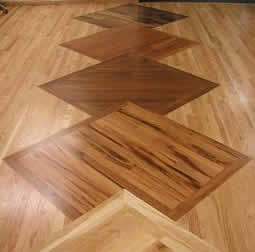One of the excellent features of hardwood flooring (Figure 1) is the ability to repair and renew the hardwood after it has been scuffed, scratched, stained or damaged. While most damages to a hardwood floor can be prevented before they happen, even under the best of circumstances things do happen. This makes hardwood flooring somewhat unique as repairs to natural stones such as marble and granite, vinyl sheet or tile, and ceramic or porcelain tile is almost impossible.

Figure 1 - Hardwood floor with diamond inlays
Note: When repairing hardwood flooring for scratches, scuff marks, stains or other damage start the renewal or repair work at the edges of the problem and continue towards the center of the problem.
Before you can undertake any repair of a hardwood floor you must know what type of finish (protective layer) has been applied. This knowledge is the key to a successful hardwood floor renewal project.
Waxed Floors:
Damage to waxed hardwood floors can usually be identified because the stain or scratch has penetrated the surface of the hardwood flooring.
Chewing Gum;
You want to freeze the chewing gum that is on the hardwood floor so that it will become brittle and the natural stickiness of the chewing gum will become non effective. To do this, fill a plastic bag with crushed ice and set it on top of the chewing gum. Wait about 10 minutes, remove the bag and the chewing gum should flake off. Thick layers of chewing gum, may require several applications.
Crayon, Candle Wax
Place an ink blotter, blotter side down, on top of the crayon or candle wax. Use a hot iron on top of the blotter to melt the crayon or candle wax. Once melted the crayon or candle wax will adhere to the blotter material.
You can also use a solvent-based wax on top of the crayon or candle wax to sofen the material that has hardened to the hardwood floor.
Cigarette Burns
For shallow cigarette burns use a ultra fine sandpaper(600 grit or higher) or #0000 steel wool moistened with some liquid floor wax. Use a circular motion to rub the sandpaper of steel wool over the damaged area.
Deep burns require the removal of the damaged fibers in the hardwood flooring. Use a razor blade knife to remove the damaged hardwood. Using sandpaper or steel wool, as previously described rub the area to remove any remaining blemish on the hardwood. After the blemish has been removed, stain the damaged area, apply wax and then hand buff to bring the damaged area to the same level as the balance of the floor.
Dark Spots, Dog Spots, Ink Stains
Dark spots or stains that have been caused by ink, or pets will require different levels of treatment depending on the depth that the stain has penetrated and its exact nature.
The initial removal attempt should be to rub the damaged location with #000 steel wool. If this removes the damage, apply wax to the area and hand buff.
If the initial attempt has not removed the damage you can try to lightly sand the area with a very fine sandpaper. After sanding use a #00 steel wool with mineral spirits or a quality hardwood floor cleaner. Once the floor has thoroughly dried, apply matching stain, wax and hand butt the affected area.
If all else fails, apply some household bleach or vinigar to the damaged area. Allow the bleach or vinigar to remain on the floor for about an hour or so. Remove any bleach or vinigar residue with a clean, damp cloth. Once the spot is completely dry, smooth any raised grain with ultra fine sandpaper. Stain the damaged area to match the rest of the hardwood flooring, wax and hand buff to match.
